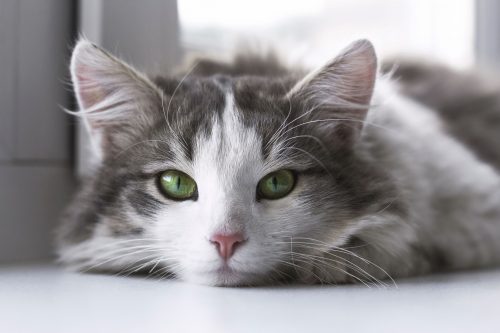The liver is essential for your cat’s body to function. The largest internal organ, it is in charge of essential functions, including several processes necessary for metabolism and detoxification.
But what happens when the liver, the largest internal organ and one charged with so many life-sustaining tasks, fails?
Read on to find out more about the functions of the liver, plus the symptoms and signs which point to a cat afflicted by liver failure.
What Are The Functions of The Liver?
The liver is a vital organ found in the abdomen, beneath the diaphragm. Shown in most medical texts as a large, reddish-brown mass, the liver is both complex and hard-working. It performs over 1,000 tasks necessary to live which could not be carried out anywhere else in the body.
Among many important tasks, the liver is primarily responsible for:
- Processing nutrients from the blood
- Removing waste products
- Producing and secreting enzymes to aid in digestion such as bile, which absorbs fat
- Breaking down hemoglobin
- Converting sugar into glycogen for energy
- Metabolizing drugs and medications
- Storing fat-soluble vitamins A, D, E, and K as well as iron, copper, and zinc
- Manufacturing essential hormones such as IGF-1, a growth hormone
- Regulating chemicals in the bloodstream
- Balancing estrogen and testosterone
- Processing hemoglobin
- Producing certain proteins for the blood plasma
- Transforming ammonia, a toxic byproduct of protein metabolism, into urea
The good news? This vital organ is capable of regenerating itself—and is, incidentally, the only organ in the body able to do so. But what happens when the liver becomes damaged, or worse yet, fails?
What is Liver Failure in Cats?
Hepatic failure, or acute liver failure in cats, is a condition characterized by the sudden loss of 70 percent or more of the liver’s function. This diseased state may be due to sudden, massive liver tissue death.
How Do I Know if My Cat Has Liver Failure?
A visit to your vet is necessary to diagnose liver failure. Several labs will be taken, and your veterinarian will also need to know your cat’s symptoms and history.
Though all these tests can help diagnose an acute liver failure, a biopsy may still be necessary to obtain a definitive diagnosis.
Here are the symptoms and signs to look out for:
Symptoms and Signs of Cat Liver Failure
The first sign to look out for is a loss of appetite in cats or anorexia. The following are also common signs of liver failure in cats:
- Jaundice (yellowing of the eyes, inner ears, and mucous membranes)
- Sudden weight loss from anorexia
- Weakness and lethargy
- Vomiting
- Diarrhea
- Blood in the stool
- Seizures
- Fluid-filled, swollen abdomen
- Depression
Because the liver is involved in so many bodily functions, the failure of this essential organ affects other organ systems, too. Acute liver failure can affect the body through several system failures:
- Gastrointestinal: characterized by vomiting, diarrhea, and blood in the stool
- Nervous system: brain disease from liver failure
- Hepatobiliary: this system includes the liver plus the gallbladder, and manifests in jaundice plus death of the liver and bile duct cells
- Renal: injury to the tubules of the kidney due to toxins/metabolites
- Immune, Lymphatic, and Hemic: clotting due to imbalances in the blood and lymphatic systems
Treating Liver Failure in Cats
If you notice any of the previous signs and symptoms in your cat, schedule an appointment with your veterinarian. Through a variety of tests, your vet will be able to determine if your cat does, in fact, have liver failure.
Your vet may prescribe fluid therapy and/or a feeding tube to help remedy the effects. Fluid therapy helps prevent dehydration and administers electrolytes and sugar to correct any imbalances in the body, including low blood sugar. A feeding tube is useful in delivering calories, proteins, and nutrients straight to the stomach or intestines.
In addition, the veterinarian may also prescribe one or a number of medications, both to treat complications throughout the body as well as to treat the primary cause. Medications include:
- Antibiotics to kill bacteria or infections in the liver and/or other organs
- Antioxidants to promote healing
- Hepatoprotectants, which prevent additional damage to the liver
- Antiemetics to ease and treat vomiting or nausea
- Diuretics are used to remove excess fluid from the body and reduce swelling
- Mannitol to decrease swelling in the brain
- Lactulose, which stops ammonia absorption
- Antiulcer medications
- Coagulopathy medications, which help prevent internal bleeding
Sources:
- “Liver Disease in Cats.” PetMD, Accessed 27 Dec. 2017. www.petmd.com/cat/conditions/digestive/c_ct_hepatic_lipidosis.
- “Fatty Liver Disease in Cats: Not Eating Can Quickly Kill.” Pet Health Network, Accessed 27 Dec 2017. www.pethealthnetwork.com/cat-health/cat-diseases-conditions-a-z/fatty-liver-disease-cats-not-eating-can-quickly-kill.
- “Symptoms of Liver Disease in Cats.” Petfinder, Accessed 27 Dec 2017. www.petfinder.com/cats/cat-health/cat-liver-disease-symptoms/.
- “Acute Liver Failure in Cats – Symptoms, Causes, Diagnosis, Treatment, Recovery, Management, Cost.” WagWalking, 12 Oct. 2016, Accessed 27 Dec 2017. www.wagwalking.com/cat/condition/acute-liver-failure.
- “Liver Disease in Cats.” Vetwest Animal Hospitals, 6 Apr. 2016, Accessed 27 Dec 2017. www.vetwest.com.au/pet-library/liver-disease-in-cats.






